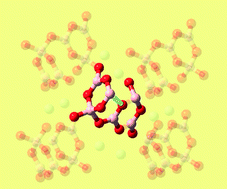In situ Raman investigation of a LiB3O5 melt toward understanding the structural memory phenomena†
Abstract
Lithium triborate (LiB3O5, LBO) is the most widely used nonlinear optical crystal. During the LBO crystal melting process, several interesting and important phenomena, called as structural memory, have been found. However, the essence of these phenomena remains unclear. In order to explain these phenomena, high-temperature Raman spectroscopy was used to investigate in situ the structures of a LiB3O5 melt at different temperatures. Two important structural transformations were found during the LBO crystal melting process: (1) when the crystal begins to melt, every two adjacent basic building units (B3O4Ø2) in the crystal structure transforms to a B4O5Ø4 group and a B2O3 molecule. (2) Above 860 °C, the B4O5Ø4 units react with the B2O3 molecules to form boron–oxygen chains whose minimal repeated unit is the B3O4Ø2 six-membered ring. These results prove that LBO is an incongruently melting compound and provide a rationale for understanding the special structural memory phenomena.


 Please wait while we load your content...
Please wait while we load your content...